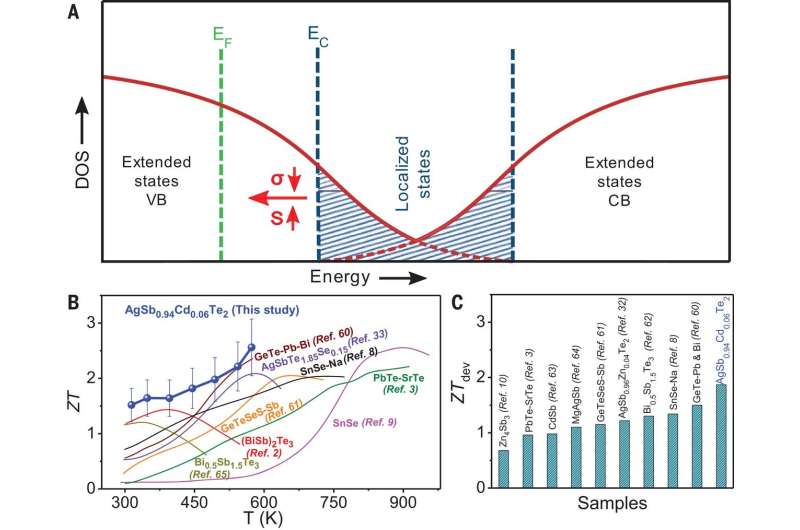Schematic of disorder-tuning of electronic structure and thermoelectric performance of Cd-doped polycrystalline AgSbTe2. Credit: Science (2021). DOI: 10.1126/science.abb3517
A team of researchers affiliated with multiple institutions in India and one in China has found a way to improve the performance of a certain thermoelectric material by partially substituting selective atoms with certain cations. In their paper published in the journal Science, the group describes their process and how well their material worked when tested. Yu Liu and Maria Ibáñez with the Institute of Science and Technology Austria have published a Perspectives piece in the same journal issue outlining prior work involved in attempting to improve the performance of thermoelectric materials and describe the work done by the team in this new effort.
Thermoelectric materials are used in a wide variety of applications, mostly involving cooling and heating in refrigeration and power generation systems—most of the current work involves looking for materials that can be used to create electricity from waste heat during manufacturing processes. They are, as their name implies, materials that have properties that allow for producing electricity under the influence of heat. Researchers have identified three major characteristics when looking for a good candidate material: good electrical conductivity, low thermal conductivity and a high Seebeck coefficient.
The challenge for chemists looking to find, make or change another material to improve its thermoelectric performance is that these three major characteristics can conflict with one another—improving one can negatively impact another. In this new effort, the researchers have found a way to sidestep such concerns for one specific material: silver antimony telluride (AgSbTe2). Their approach involved partially substituting the antimony atoms with the cation cadmium. Doing so led to a pair of different ordered phases forming in the nanoscale domains, which led to improvements in electrical properties and decreases in thermal conductivity. The net result was an improvement in performance without creating other problems that might prevent the material from being used in a commercial application.
Testing of the doped material showed it able to deliver a device efficiency of 1.5 at room temperatures, 2.6 at 573K—and an overall average of 1.8, which Liu and Ibáñez note, are some of the highest efficiency improvements for such materials to date.
More information: Subhajit Roychowdhury et al. Enhanced atomic ordering leads to high thermoelectric performance in AgSbTe2, Science (2021). DOI: 10.1126/science.abb3517
Yu Liu et al. Tidying up the mess, Science (2021). DOI: 10.1126/science.abg0886
Journal information: Science
© 2021 Science X Network
























